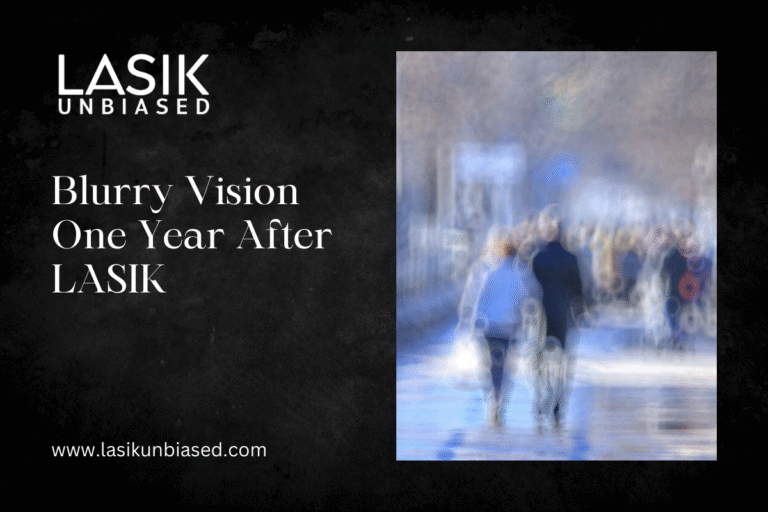Experiencing blurry vision a year after LASIK is uncommon but not unheard of.
While LASIK is generally a safe and effective procedure, various factors can contribute to post-operative vision changes even after a significant recovery period.
Understanding the Basics of LASIK Surgery
LASIK is a well-known laser eye surgery that helps correct vision problems like nearsightedness, farsightedness, and astigmatism. The process involves reshaping the cornea to improve how light is focused on the retina, ensuring clear vision. Post-surgery outcomes are typically excellent, with most patients achieving 20/20 vision or better.
However, outcomes can vary, and it’s vital to understand that LASIK doesn’t guarantee a permanent clear vision. Some patients experience side effects such as dry eyes, glare, or haloes, which are expected during the initial healing phase but may occasionally resurface later.
Possible Causes of Blurry Vision One Year After LASIK
Blurry vision a year post-surgery could be linked to several factors. Identifying the underlying cause is essential for addressing the issue in an effective manner.
1. Regression of Vision
Regression refers to a partial return of the refractive error that was initially corrected during LASIK. Over time, the cornea can revert to its previous shape, causing vision problems.
- Why it Happens?
Corneal healing processes or changes in tissue can occasionally reverse part of the correction achieved during LASIK.
- Signs to Watch For
Blurry vision, particularly for distances that were previously sharp, is a key indicator of regression.
2. Dry Eye Syndrome
LASIK can permanently alter how the eyes produce and distribute tears, potentially leading to chronic dry eye.
- Why it Happens?
Nerve endings in the cornea are temporarily cut during LASIK, which can disrupt tear production. For some patients, the effects may persist longer than expected.
- Symptoms Related to Blurring
Discomfort, redness, and a gritty sensation often accompany intermittent blurriness caused by dry eye.
3. Presbyopia Development
If you’re in your late 30s or older, presbyopia could be a factor. This age-related vision condition results from the lens losing flexibility, affecting your ability to focus on nearby objects.
- Why it Happens?
LASIK modifies corneal shape but cannot prevent natural ageing of the eye’s lens.
- How to Recognise It?
Difficulty focusing on close-up tasks like reading or using your mobile device, even if distance vision remains unaffected.
4. Night Vision Problems
Some LASIK recipients experience night vision disturbances, such as glare or haloes, which could persist or resurface over time.
- Why it Happens?
These issues are often linked to pupil dilation in low-light conditions, exposing untreated areas of the cornea.
- Impact on Vision
While primarily affecting low-light scenarios, haloes or starbursts can occasionally blur vision overall.
5. Epithelial Ingrowth
This occurs when cells from the cornea’s outer layer grow under the LASIK flap, leading to vision problems.
- Why it Happens?
Epithelial ingrowth is rare but can occur after trauma to the flap or incomplete healing.
- Signs and Symptoms
Besides blurry vision, irritation or discomfort may occur, requiring medical evaluation.
6. Corneal Ectasia
LASIK-induced ectasia is a severe but rare side effect where the cornea progressively thins and bulges outward.
- Why it Happens?
Pre-existing corneal weakness or excessive tissue removal during LASIK can lead to ectasia.
- Symptoms
In addition to blurriness, there may be heightened sensitivity to light and a progression of astigmatism.
7. Underlying Medical Conditions
Pre-existing or developing eye conditions like cataracts, glaucoma, or macular degeneration can also cause blurry vision post-LASIK.
- Why it Happens?
LASIK does not prevent or treat unrelated eye diseases. Changes in structures like the retina or lens can affect clarity.
- What to Look For?
Gradual loss of vision, light sensitivity, or discomfort could signal an unrelated issue.
How to Address Blurry Vision After LASIK?
Blurry vision one year after LASIK can be managed effectively if tackled promptly. Here’s how to approach the issue:
1. Consult Your Surgeon
If you notice persistent vision changes, the first step is to schedule a follow-up visit with your LASIK surgeon or an optometrist. They’ll perform a comprehensive eye exam to assess your corneal health, measure refractive error, and identify the cause of blurriness. Timely intervention can often prevent complications from worsening.
2. Consider LASIK Enhancements
For cases of mild regression, a LASIK enhancement procedure might be recommended. This involves re-lifting the flap and correcting any residual refractive error. Enhancements are typically performed only after your vision has stabilised.
3. Treat Dry Eye
If dry eyes are the primary cause:
- Use preservative-free artificial tear drops or ointments regularly.
- Consider punctal plugs to improve tear retention.
- Ask about medications like cyclosporine (Restasis) that enhance tear production.
4. Opt for Corrective Lenses if Necessary
Presbyopia or minor residual refractive errors are commonly managed with prescription glasses or contact lenses specifically designed for tasks such as reading or night driving.
5. Monitor and Treat Eye Conditions Promptly
Early detection of complications like epithelial ingrowth or ectasia is key. Possible treatment options include flap repair, corneal collagen cross-linking (CXL), or speciality contact lenses like scleral lenses.
6. Adopt Home Care Measures
Healthy lifestyle adjustments can also support better eye health:
- Maintain proper hydration and a balanced diet rich in omega-3 fatty acids.
- Avoid excessive screen time or take breaks during prolonged use.
- Wear UV-blocking sunglasses to protect against harmful light exposure.
When to Seek Emergency Care?
Certain symptoms alongside blurry vision indicate an urgent issue that requires immediate medical attention, including:
- Severe eye pain.
- Sudden loss of vision.
- Redness or swelling that doesn’t subside.
- Halos or flashes that appear suddenly.
Could It Be Prevented?
While some issues causing blurry vision arise unpredictably, others can be minimised with proper preparation and post-operative care:
- A thorough pre-LASIK screening is crucial to rule out individuals unsuitable for the procedure, such as those with corneal thinning.
- Follow all post-operative instructions carefully, including attending all follow-up appointments.
- Avoid activities that could strain or harm your eyes during the healing phase.
Ensuring Peace of Mind for Post-LASIK Vision
For most LASIK patients, the one-year mark signifies stable, clear vision and freedom from corrective lenses. However, blurry vision should always prompt proactive steps to understand and resolve the issue. With timely intervention and proper care, most post-LASIK complications can be effectively managed.
If you’re dealing with blurry vision or have concerns about your LASIK results, consult an eye-care professional experienced in post-refractive surgery evaluations. Staying informed and vigilant is key to long-term success.


